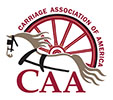
Tags and Numbers
Look for tags indicating the name and location of the manufacturer. Unfortunately, carriage tags themselves are collectible and thus are often missing from carriages. If the maker’s tag includes the city and state, such as the tag shown here, that is even more helpful. A dealer tag provides another clue. The dealer may be different than the manufacturer (as for automobiles today). Dealer tags aren’t as useful as makers tags for researching, but they might help.
Other numbers that may be found might be part numbers, such as on axles, that came from other companies. Unfortunately, after the automobile replaced the carriage as the primary mode of transportation, most carriage manufacturers went out of business, and their records were lost to posterity. Therefore, part numbers are of limited help.
 Hubs and Monograms
Hubs and Monograms
Look for any engravings on the hub; they may contain either the carriage manufacturer or the axle manufacturer. Monograms may help you find the owner.
Libraries and Historical Societies
Local historical societies and libraries frequently have newspaper articles, regional databases, and vertical files housing thousands of early documents that are applicable to your search. Sanborn fire maps dating from 1867 contained detailed information about commercial, industrial, and residential properties in thousands of communities; digital images of these maps are in the Library of Congress. Many historical societies are housed in old carriage factories and have documented the history of the building and its occupants.
Catalogs
Carriage catalogs are good places to look to identify the type of carriage. Many people want information because they wish to restore their carriage using original colors. Some catalogs, while printed in black and white, contained information about available colors. Some have been digitized and are available on-line. The CMA has a list of those on our website (www.carriagemuseumlibrary.org).
Periodicals and Journals
Old periodicals and trade journals are another excellent resource. The Carriage Monthly and The Hub are two of the most well-known journals in the CMA’s collection. The University of Michigan library has digitized almost every issue of The Hub; these can be viewed free of charge and are word-searchable. Carriage Dealers’ Journal and Rider and Driver are also available in the CMA archives. The fashion plates in these magazines may be useful. Advertisements are also excellent sources of information, as carriage catalogs are not available for every manufacturer. Ads give a hint to what was offered.
Websites
Visit local websites. Search for regional carriage museums, or visit the Carriage Association of America’s museum search page: https://www.carriageassociationofamerica.com/carriage-museums/. Sometimes museum websites will allow you to do a word search. Email the librarian and ask for help. S/he may know of a local carriage collector who can provide information. Visit the Library of Congress (www.loc.gov); its databases contain a staggering amount of information.
Patent Records
Patent records are another good source of information. These searches once were tedious, but Google has made all the U.S. patent records searchable and available in full text on-line, free of charge: www.patents.google.com. Patents will help with dating your vehicle or provide information about carriage parts, but try to narrow your search criteria as much as possible to avoid receiving 400,000+ responses to your query!
 Brewster and Cunningham Carriages
Brewster and Cunningham Carriages
The CMA has digital copies of Brewster specifications and sales records. Cunningham records are also available at the Detroit Public Library.
Carriage Museum of America Website
A “recommended reading” page is included on our website as well as a number of digitized carriage catalogs. The website also has a “virtual museum” of different types of carriages, as well as biographies of prominent carriage manufacturers.
If you undertake the research yourself, be cognizant of your sources. If you are reviewing a digitized copy of a book or a carriage catalog, you can be confident you are looking at the original source. Do not depend on Wikipedia!! It is not an academically accepted resource. While perhaps it can give you some clues for further research, the source of the information is not reliable.
The Carriage Museum of America is located at the Kentucky Horse Park in Lexington. Please stop by (call us to be sure we are here to greet you) or email us with your questions. Our phone number is 859-259-2933; our email is cmalibrary@windstream.net; and our website is www.carriagemuseumlibrary.org. Be sure to visit our Facebook page, but please direct your questions to our email address or call us.
